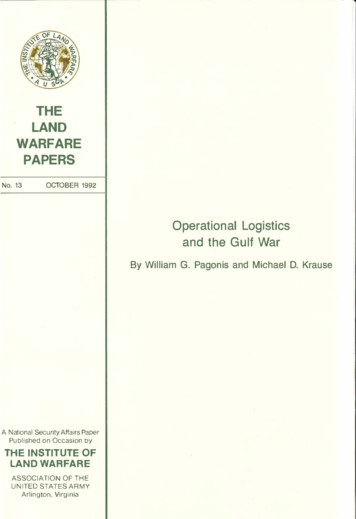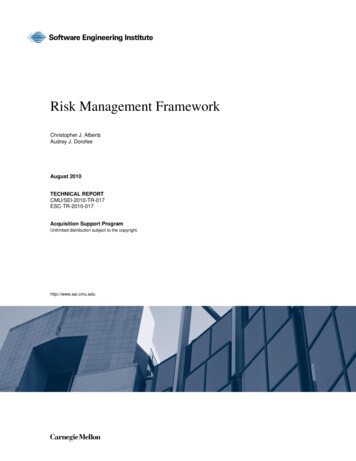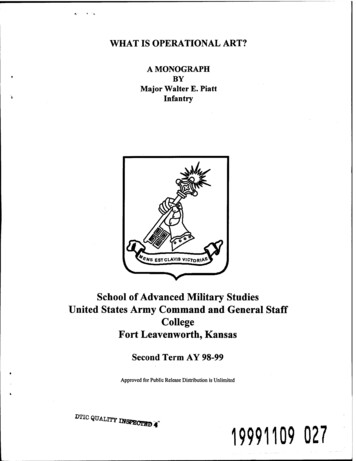
Transcription
Operational Risk Integrated OnlineNetwork (ORION)Policy DocumentApplicable to:1. Licensed banks2. Licensed Investment banks3. Licensed Islamic banks4. Licensed International Islamic banks5. Licensed insurers6. Licensed takaful operators7. Licensed international takaful operators8. Prescribed development financial institutions9. Approved issuers of a designated payment instrument10. Approved issuers of a designated Islamic payment instrumentIssued on: 25 February 2021
Page 2 of 94TABLE OF CONTENTSPART A: OVERVIEW . 41.2.3.4.5.6.7.Introduction . 4Applicability . 4Legal provisions . 4Effective date . 4Interpretation . 4Policy document superseded. 6Enquiries and correspondence . 7PART B: POLICY REQUIREMENTS . 88.9.10.11.Overview of the responsibilities of reporting entities . 8Roles and responsibilities of ORION users . 8Access to ORION . 9Registration of ORION users . 9PART C: REPORTING REQUIREMENTS . 1012.13.14.15.16.17.18.ORION reporting requirements . 10Scope of reporting . 11Reporting currency . 11Classification and quantification . 11Additional reporting requirements . 14Key risk indicators . 14Scenario analysis . 14APPENDICES. 16APPENDIX 1APPENDIX 2APPENDIX 3APPENDIX 4APPENDIX 5APPENDIX 6APPENDIX 7APPENDIX 8APPENDIX 9APPENDIX 10APPENDIX 11APPENDIX 12APPENDIX 13APPENDIX 14APPENDIX 15ORION user guide and technical specifications . 16Operational risk event reporting requirements . 16Cyber threat reporting requirements . 20BDSF event reporting requirements . 26Boundary event reporting requirements . 27Customer information breaches reporting requirements . 28Insurance-related event reporting requirements . 33SNC event reporting requirements . 38Payment-related fraud event reporting requirements . 45Aggregate reporting requirements . 58Overseas loss event reporting requirements . 67Business lines taxonomy . 70Event types taxonomy . 76Causal categories taxonomy . 84Key risk indicators taxonomy . 86Issued on: 25 February 2021
Page 3 of 94LIST OF TABLESTable 1Table 2Table 3Table 4Table 5Table 6Table 7Table 8Table 9Table 10Table 11Table 12Table 13Table 14Table 15ORION reporting requirements . ORION Reporting types and timelines . . .Timeline for KRI reporting to ORION . .Data fields for operational risk event reporting .Types of cyber threats BDSF event reporting types .SNC specific data fields .Payment-related fraud types .Card-related fraud MO . .Network based e-money scheme MO . .Cheque fraud MO . . Internet banking fraud MO Mobile banking fraud MO .Aggregate reporting types and threshold .Overseas loss event reporting requirements. Issued on: 25 February 2021101314162026404546474748495867
Page 4 of 94PART A: OVERVIEW1.Introduction1.1The sound operational risk management requires a comprehensiveidentification and assessment of Operational Risk as well as monitoring ofOperational Risk exposures through indicators such as Loss Event Data,Key Risk Indicators and Scenario Analysis.1.2The objective of this policy document is to require reporting entities (REs)to submit information to the Bank with regard to operational risk exposure.1.3This policy document sets out the requirements for the reporting of LossEvent Data, Key Risk Indicators and Scenario Analysis to the Bank throughthe ORION.2.Applicability2.1This policy document is applicable to REs as defined in paragraph 5.2.3.Legal provisions3.1This policy document is issued pursuant to:(a)sections 47(1) and 143(2) of the Financial Services Act 2013 (FSA);(b)sections 57(1) and 155(2) of the Islamic Financial Services Act 2013(IFSA); and(c)section 41(1) and constitutes a notice under section 116(1) of theDevelopment Financial Institutions Act 2002 (DFIA).3.2The guidance in this policy document is issued pursuant to section 266 ofthe FSA, section 277 of the IFSA and section 126 of the DFIA.4.Effective date4.1This policy document comes into effect on 1 March 2021.5.Interpretation5.1The terms and expressions used in this policy document shall have thesame meanings assigned to them in the FSA, IFSA or DFIA, as the casemay be, unless otherwise defined in this policy document.5.2For the purpose of this policy document:“S” denotes a standard, an obligation, a requirement, specification,direction, condition and any interpretative, supplemental and transitionalprovisions that must be complied with. Non-compliance may result inenforcement action;Issued on: 25 February 2021
Page 5 of 94“G” denotes guidance which may consist of statements or informationintended to promote common understanding and advice orrecommendations that are encouraged to be adopted;“BDSF” refers to business disruption and system failure;“CRO” means the Chief Risk Officer of a RE;“Financial group” refers to a financial holding company approved by theBank or a licensed institution, and a group of related corporations undersuch financial holding company or licensed institution primarily engaged infinancial services or other services which are in connection with or for thepurposes of such financial services which includes at least one licensedperson;“Financial institutions” or “FIs” means:(a)licensed banks, licensed investment banks and licensed insurersunder the FSA;(b)licensed Islamic banks which includes licensed international Islamicbanks, and licensed takaful operators which includes licensedinternational takaful operators under the IFSA; and(c)prescribed institutions under the DFIA;“GCRO” means the Group Chief Risk Officer of a RE;“Loss Event Data” or “LED” refers to information required for assessingan entity’s exposure to operational risk and the effectiveness of its internalcontrols. The purpose of the analysis of LED is to provide insight into thecauses for large losses and whether control failures are isolated orsystematic in nature. Identifying how operational risk may lead to credit riskand market risk-related losses also provides a more holistic view of theoperational risk exposure;“Key Risk Indicators” or “KRIs” refer to information that will provideinsight into the operational risk exposure and are used to monitor the maindrivers of exposure associated with the key risks;“Operational Risk” has the same meaning assigned to it under the PolicyDocument on Operational Risk issued by the Bank on 10 May 20161andincludes any amendments made thereof from time to time. For ease ofreference, Operational Risk refers to the risk of loss resulting frominadequate or failed internal processes, people and systems, or fromexternal events. Operational risk is inherent in all activities, products andservices of financial institutions and can transverse multiple activities andbusiness lines within the financial institutions. It includes a wide spectrumof heterogeneous risks such as fraud, physical damage, businessdisruption, transaction failures, legal and regulatory breaches 2 as well asemployee health and safety hazards. Operational risk may result in direct12Paragraph 1.1 of the Policy Document on Operational Risk.Including fiduciary breaches and Shariah non-compliance by Islamic financial institutions.Issued on: 25 February 2021
Page 6 of 94financial losses as well as indirect financial losses (e.g. loss of businessand market share) due to reputational damage;“ORION” refers to the Operational Risk Integrated Online Network;“Payment instrument issuers” or “PIIs” mean:(a)approved issuers of a designated payment instrument under theFSA; and(b)approved issuers of a designated Islamic payment instrument underthe IFSA;“Reporting entities” or “REs” refer to financial institutions and paymentinstrument issuers;“Scenario Analysis” or “SA” refers to an assessment made by an entityto identify potential operational risk events and assess potential outcomesincluding identifying potential significant operational risks and the need foradditional risk management controls or mitigation solutions;“SNC” refers to Shariah Non-Compliance;“Control function” refers to the definition as provided in the policydocument on Corporate Governance issued by the Bank and includes anyamendments made to thereof from time time; and“Officer within the control function” means an officer that meets thefollowing criteria:(a)Performs one of the control functions under Shariah governance(i.e. Shariah risk management, Shariah review or Shariah audit);(b)Independent from the business lines and not involved in revenuegeneration activities; and(c)Possesses sound understanding of relevant Shariah requirementsapplicable to Islamic financial business.6.Policy document superseded6.1This policy document supersedes the policy document on Operational RiskReporting Requirement – Operational Risk Integrated Online Network(ORION) issued on 22 June 2018.6A.Related legal instruments and policy documents6A.1 This policy document must be read together with other relevant legalinstruments and policy documents that have been issued by the Bank, inparticular –(a)Operational Risk issued on 10 May 2016 ;(b)Corporate Governance issued on 3 August 2016 for FSA and IFSA;(c)Corporate Governance issued on 13 December 2019 for DFIA;Issued on: 25 February 2021
Page 7 of 94(d)Shariah Governance Policy Document issued on 20 September2019;(e)Risk Management in Technology (RMiT) issued on 19 June 2020;(f)Management of Customer Information and Permitted Disclosuresissued on 17 October 2017;(g)Guidelines on Business Continuity Management (Revised) issuedon 3 June 2011;(h)Guidelines on Handling of Suspected Counterfeit MalaysianCurrency Notes issued on 2 September 2014;(i)Letter on the ‘Implementation of Financial Stability Board’s CyberLexicon and Bank Negara Malaysia’s Cyber Incident ScoringSystem for the Financial Institutions’ issued on 28 September 2020;and(j)ORION Frequently Asked Questions (FAQ) document 3.7.Enquiries and correspondence7.1All enquiries and correspondences relating to this policy document shall beaddressed to:PengarahJabatan Pakar Risiko dan Penyeliaan TeknologiBank Negara MalaysiaJalan Dato’ Onn50480 Kuala LumpurFax No: 03-26970086Email: oprisku@bnm.gov.my3For avoidance of doubt, REs must refer to the FAQ document in its entirety notwithstanding any directreference made in this policy document to a specific paragraph in the FAQ document.Issued on: 25 February 2021
Page 8 of 94PART B: POLICY REQUIREMENTS8.Overview of the responsibilities of reporting entitiesS8.1The REs must prepare and submit data and information on LED, KRIs andSA to the Bank through ORION in accordance with the requirementsspecified under section 12 entitled “ORION Reporting Requirements” ofthis policy document.S8.2The REs must ensure that the data and information is consolidated andcentralised at the entity level prior to submitting the information to the Bank.S8.3The REs must put in place appropriate internal governance and processesto ensure completeness, accuracy and timeliness of the data andinformation submission to the Bank, including processes for consolidation,validation as well as reconciliation of such data and information with theRE’s internal database, system and financial accounts.9.Roles and responsibilities of ORION usersGCROS9.1The GCRO or any other officer authorised by the RE to act in that capacity,is required to ensure the RE’s compliance with the reporting requirementsset out in this policy document.CROS9.2The CRO or any other officer authorised by the RE to act in that capacity,must ensure the RE’s compliance with the reporting requirements set outin this policy document.S9.3The CRO shall:(a)appoint a Submission Officer to perform the functions set out inparagraph 9.4; and(b)ensure that the reporting requirements in this policy document arecomplied with at all times, including in the absence of theSubmission Officer.Submission OfficerS9.4The Submission Officer shall:(a)prepare the data and information for submission to the Bankthrough ORION;(b)ensure that the data and information to be submitted to the Bank isaccurate, complete and have been consolidated at the entity leveland reconciled with internal reports and databases;(c)ensure the successful transmission of the data and information tothe Bank within the timeline specified under each data category;Issued on: 25 February 2021
Page 9 of 94(d)(e)10.perform corrections, make amendments and provide updates on thesubmitted data and information upon having knowledge of anyinaccuracy in the data; andliaise with the Bank on matters pertaining to the data andinformation to be submitted or generally on the ORION.Access to ORIONFinancial group structureG10.1In the case of REs operating as financial groups, access to ORION will begranted to the GCRO, CRO and Submission Officer.Single entity structureG10.2In the case of REs operating on stand-alone basis, access to ORION willbe granted to the CRO and Submission Officer.Adoption of structureS10.3The REs must notify the Bank in writing on the type of reporting structurethat it intends to adopt.11.Registration of ORION usersDetails to be registeredS11.1The REs must register the following details of the GCRO, CRO andSubmission Officer at FI@KijangNet portal at www.bnm.gov.my:(a)Name(b)Designation(c)Email address(d)Phone numberRefer to FAQ No. 2.Changes in GCRO, CRO and Submission OfficerS11.2The REs must notify the Bank in writing of any changes to the GCRO, CROor Submission Officer and to update such details accordingly atFI@KijangNet portal. Please refer to FAQ No. 2.S11.3The REs must ensure that any changes to the GCRO, CRO or SubmissionOfficer will not impact the timeliness of data and information submission tothe Bank.Issued on: 25 February 2021
Page 10 of 94PART C: REPORTING REQUIREMENTSS12.ORION reporting requirements12.1The REs must submit information to the Bank through ORION inaccordance with Table 1: ORION reporting requirements.Table 1: ORION reporting requirementsAppendices DescriptionAppendix 1ORION user guide & technicalspecificationsApplicabilityREsAppendix 2Operational risk event reportingrequirementsREsAppendix 3Cyber threat reportingrequirementsFIsAppendix 4BDSF event reportingrequirementsFIsAppendix 5Boundary event reportingrequirementsFIs except LicensedInsurers & TakafulOperatorsAppendix 6Customer information breachesreporting requirementsREsAppendix 7Insurance-related event reportingrequirementsLicensed Insurers &Takaful OperatorsAppendix 8SNC event reporting requirementsFIsAppendix 9Payment-related fraud eventreporting requirementsREs exceptLicensed Insurers &Takaful OperatorsAppendix 10Aggregate reporting requirementsREsAppendix 11Overseas loss event reportingrequirementsFIsAppendix 12Business lines taxonomyFIsAppendix 13Event types taxonomyFIsAppendix 14Causal categories taxonomyFIsAppendix 15Key risk indicators taxonomyFIsIssued on: 25 February 2021
Page 11 of 9413.Scope of reportingS13.1The REs must report all operational risk events in accordance with therequirements and timeline set out in Table 2: ORION Reporting typesand timelines. The reporting must also include the operational risk eventsof foreign and offshore subsidiaries or branches of the REs which resultedin financial-related losses.S13.2 The REs shall submit to the Bank the LED module for events that occurredfrom 22 September 2014 onwards and the KRI module data for events thatoccurred from 1 October 2014 onwards.S13.3For reporting of the operational risk events of foreign and offshoresubsidiaries or branches of the REs, REs must notify the Bank ofchallenges faced by the REs in meeting the reporting requirements of thispolicy document. A waiver must be obtained from the Bank for failure byREs to comply with reporting requirements under such circumstance.14.Reporting currencyS14.1All amounts must be reported by REs in Ringgit Malaysia (RM).S14.2REs must use its applicable internal exchange rate to convert loss amountsto RM in the instance where a financial loss is in a foreign currency.15.Classification and quantificationFinancial related operational risk eventS15.1REs must classify financial-related events in accordance with the following:(a)Actual Loss – Actual Loss refers to an event that resulted in ameasurable loss in the RE’s Profit and Loss account. Accountingtreatment must be applied in accordance with the RE’s accountingpolicies.(b)Potential Loss – Potential Loss refers to a conservative estimateof the loss amount until actual loss can be determined. Accountingtreatment must be applied in accordance with RE’s internal policy.(c)Near Miss – Near Miss refers to an event which financial losseshave been averted by controls or mitigating actions.S15.2Where a provision is made in the Profit and Loss account for themeasurable loss of an on-going event, the amount must be classified bythe REs as ‘Actual Loss’ in ORION. The ‘Actual Loss’ amount must beadjusted by the REs if the amount for the provision is subsequentlychanged.S15.3Indirect Loss which was resulted from an Operational Risk event must notbe included by REs in the calculation of the actual and potential lossamount reported in ORION.Issued on: 25 February 2021
Page 12 of 94Non-financial related operational risk eventS15.4 REs must classify Non-Financial-related events in accordance with thefollowing:(a)High impact - which caused severe damage to reputation thatresulted in long term effect on business credibility;(b)Medium impact - which caused moderate damage to reputationthat resulted in medium term effect on business credibility; or(c)Low impact - which caused insignificant damage to reputation thatdid not result in any damage on business credibility.Issued on: 25 February 2021
Page 13 of 94Table 2: ORION reporting types and timelinesReportable operational risk eventsCriticaleventClassificationTimelineRobbery and theft Self Service Terminals (SST)4 robbery Robbery and theft events RM 200k Actual Potential Near missBy T 1 working day, Tbeing the date of eventconfirmationCyber threat As defined in Appendix 3 Actual Near MissReputational Impact High impact events as defined by REsinternal policy ActualAll operational risk events RM 1mil Actual PotentialCritical BDSF As defined in Appendix 4By T 2 working days, Tbeing the date of eventconfirmation ActualNew modus operandi (MO) New type of fraud MO committed andimpacted the REs for the first time Actual PotentialCustomer information breaches As defined in Appendix 6 ActualBy T 1 working day, Tbeing the date ofinvestigation is tabled tothe BoardActual SNC As defined in Appendix 8 ActualPotential SNC As defined in Appendix 8 PotentialBy T 1 working day, Tbeing the date of SNCconfirmation by ShariahCommittee (SC)By T 1 working day, Tbeing the date of eventconfirmation by anofficer within the controlfunctionFraudeventAll fraud types Payment-related fraud is defined inAppendix 9 Other fraud events Actual Potential Near missBy the 15th calendar dayof the following month orearlierOtherlosseventAggregate reportingAs defined in Appendix 10 All card fraud (Credit Card, DebitCard, Charge Card) with amountinvolved RM 5kSNCevent Actual Potential Near miss All actual loss RM 1k Physical cash shortages ActualOverseas loss events As defined in Appendix 11 ActualAll other loss events All events other than specified abovewith financial losses Actual4Self Service Terminals (SST) are Automated Teller Machines (ATMs), Cash Deposit Machines(CDMs) and Cash Recycler Machines (CRMs).Issued on: 25 February 2021
Page 14 of 9416.Additional reporting requirementsS16.1All submission to ORION must not contain any customer information oremployee data to satisfy data secrecy and data privacy.S16.2All on-going Operational Risk events must be re-assessed and updated toreflect changes to event classification and latest information.S16.3Notwithstanding the timeline for reporting of critical events as stated inTable 2, the REs must notify the Bank on the occurrence of critical eventsthrough other communication channels at the earliest opportunity upon thedetection of the event.17.Key risk indicatorsS17.1FIs must submit information on the KRIs according to the applicability,description and frequency set out in Appendix 15 – Key risk indicatorsTaxonomy.G17.2The Bank may define the KRIs at the following levels:(a)entity level, i.e. generic KRIs that can be aggregated on anenterprise-wide basis;(b)specific to a business line; or(c)shared across multiple business lines.S17.3The FIs must report the KRIs to the Bank within the timeline specified inTable 3 below.Table 3: Timeline for KRI reporting to ORIONKRI frequencyReporting deadlineMonthlyBy the 10th calendar day of the following monthGQuarterlyBy the 15th calendar day of the following monthSemi-annuallyBy the 15th calendar day of the following monthAnnuallyBy the 15th of January of the following year18.Scenario analysis18.1Scenario Analysis (SA) is a systematic process in the creation of plausibleoperational risk events and has become an essential element in theoperational risk management and measurement. It is one of the operationalrisk management tools5, however, unlike the others, it is a forward-lookingtool that examines and explores predominantly emerging risks and raretail-end events which are usually low frequency high impact events.Subsequently, the FIs will be able to incorporate the controls on theseevents to mitigate the risk exposures of those scenarios. By thinking5Operational Risk Management tools are LED, RCSA, KRI and SAIssued on: 25 February 2021
Page 15 of 94through the impact of various scenarios, FIs can enhance its contingencyplans or business continuity management plans.S18.2As part of the Bank’s mandate to promote the safety and soundness of FIsin the financial system, the FIs shall respond to the SA exercise which isexecuted through ORION via the SA modules where the Bank requires forthe FIs to do so.S18.3FIs must conduct SA as and when it may be required by the Bank andsubmit the results of the SA and other information to the Bank withinprescribed time.Issued on: 25 February 2021
Page 16 of 94APPENDICESAPPENDIX 11.ORION user guide and technical specificationsPlease refer to the attached document.APPENDIX 2Operational risk event reporting requirementsORION data fields requirements1.REs must report the following information for each operational risk eventas guided in Table 4 below. Additional data fields for SNC, payment-relatedfraud and aggregate operational risk related events are provided inAppendix 8, Appendix 9 and Appendix 10 respectively.Table 4: Data fields for operational risk event reportingData fieldsMandatory DescriptionfieldReportingEntity NameYes To select the respective reporting entity foroperational loss event(Note: Applicable to Financial Group structure) Reporting entity name will be automaticallydisplayed for a ‘Single’ entityNature ofEventYes New - New type of MO impacted the REs for thefirst time. Repeated - MO that has occurred previously atREsRefer to FAQ No. 35.EventClassificationYesOperational risk events must be classified as eitherone of the following: Actual loss Potential loss Near missIslamicBusinessYes (if theevent isrelated toIslamicproduct /business)( ) – If the operational risk event is relating to Islamicbusiness or productYesFIs must select one:(a) Yes Event reported as ‘actual’ SNC or ‘potential’SNC(b) No Event classified as non-SNC(Note: For specific Shariah related fields, pleaserefer to Appendix 8)Shariah NonComplianceIssued on: 25 February 2021(Note: If the event is no longer classified as SNC,Islamic Business box must remain checked ( )because the operational risk event is related toIslamic business or product)
Page 17 of 94Data fieldsMandatory DescriptionfieldLoss EventNameYesClear and concise name that summarise the natureof the loss eventInternal LossEvent IDYesREs are required to generate its own internal ID foreach loss event reported in ORIONBusinesslines YesMust be reported up to Level 3 (banking) and Level2 (insurance) in accordance with the taxonomy inAppendix 12Product /ServicesYesConditionally populated; please select oneDeliveryChannelYesConditionally populated; please select oneEventcategories*YesMust be reported up to Level 3 in accordance withthe taxonomy in Appendix 13Causalcategories*YesMust be reported up to Level 3 in accordance withthe taxonomy in Appendix 14Country ofEventsYesCountry where the loss was incurredState ofEventsYesConditionally populated for operational risk eventoccurred in MalaysiaDistrict ofEventsYesConditionally populated for operational risk eventoccurred in MalaysiaDate of EventOccurrenceYesThe date of the operational risk event took placeDate of EventDetectionYesThe date of operational risk event confirmation isobtainedLoss EventDescriptionYes1. General operational risk eventAn executive summary of the loss event and shallinclude the following details:(a) Chronology of the loss event Where the event took place How the event occurred The modus operandi involved Parties involved in the event (e.g. customer /staff / outsourced service provider / affiliates,etc.) Number of customers affected by the event Number of business lines affected The root cause of the event(b) Remedial actions to resolve the event(c) Mitigating action plans to prevent recurrence ofsimilar incident in the future* Those marked with asterisks are not applicable to PIIsIssued on: 25 February 2021
Page 18 of 94Data fieldsMandatory Descriptionfield(d) Indication of timeline when the event can beresolved(e) Progressive update of the event post-reportingto ORIONThe executive summary must not include customer /individual confidential information e.g. Name, I/Cnumber, account number and other personalinformation2. Aggregate operational risk eventFor further description and reporting format onaggregate reporting, please refer to Appendix 10Event ValidTillNoTo remove existing operational risk event in ORION;this field is only applicable for genuine duplicatedreporting in ORIONReasonYes (if theabove isselected)The reason for the removal of the loss event must beprovidedEvent ImpactYesPlease choose one event impact from the following: Financial impact - There is an actual orpotential financial loss Non-financial impact – No loss amount involvedbut has impact on reputation, non-compliance etc. Both financial and non-financial – as definedaboveFinancialImpact Event ForYesRE must select whichever applicable: Event for Banking Event for ATM Acquirer Event for Payment Instrument Event for Payment Channel Event for Insurance & Takaful OperatorFinancialImpact Event ForYes BankingFinancialImpact Event ForYes ATM AcquirerPlease refer to Appendix 9FinancialImpact Event ForYes Payment instrumentPlease refer to Appendix 9 REs must identify whether the operational lossevent have boundary implications in accordancewith Appendix 5 If the loss event is identified as a boundary event,REs must categorise either as Credit Risk orMarket Risk relatedIssued on: 25 February 2021
Page 19 of 94Data fieldsMandatory DescriptionfieldFinancialImpact Event ForFinancialImpact Event ForYes Payment channelPlease refer to Appendix 9Yes Insurance &Takaful OperatorAmountInvolvedYesThis field must have a value to reflect the overallfinancial amount associated with the operational riskevent reportedFinancialImpact (forBanking, ATMAcquirer andPaymentChannel) ActualLoss /PotentialLoss /RecoveriesYesREs to record the actual loss / potential loss /recovery amount incurred according to the followingcategories: Reporting Entity Customer 3rd PartyREs must identify the insurance category impactedfrom: Assets Claims Premium Re-insurance Intermediaries OthersThe REs must not use losses net of i
SA to the Bank through ORION in accordance with the requirements specified under section 12 entitled "ORION Reporting Requirements" of this policy document. 8.2 The REs must ensure that the data and information is consolidated and centralised at the entity level prior to submitting the information to the Bank.











